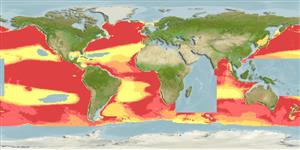>
Gadiformes (Cods) >
Macrouridae (Grenadiers or rattails)
Etymology: Coryphaenoides: Greek, koryphaina = dolphin fish + Suffix oides = similar to (Ref. 45335); armatus: From 'cyklos' meaning circle and 'lepis' meaning scale (Ref. 6885).
Environment: milieu / climate zone / depth range / distribution range
Écologie
marin bathypélagique; profondeur 282 - 5180 m (Ref. 50610). Deep-water; 65°N - 61°S, 180°W - 180°E (Ref. 1371)
Worldwide: marginal to the Southern Ocean (Ref. 5171).
Taille / Poids / Âge
Maturity: Lm ? range ? - ? cm
Max length : 102 cm TL mâle / non sexé; (Ref. 1371)
Épines dorsales (Total): 2; Rayons mous dorsaux (Total): 123-124; Épines anales 0; Rayons mous anaux: 115. The head is large; the eyes also large. The snout is elongated, somewhat conical; the mouth is small and inferior. The body tapers from behind the first dorsal fin. The light organ extends past midway between the anal origin and the ventral insertion. Color is uniformly brownish, except for the abdomen which is bluish.
A deep-slope upper continental rise species, common in deep waters of most oceans (Ref. 1371). Bathypelagic (Ref. 58426). Feeds on a variety of benthic invertebrates (especially crustaceans and holothuroids) when young, switching to primarily mesopelagic and bathypelagic fish, and sea urchins and cephalopods as adults (Ref. 1371). Sex ratio was 2.6:1 male to female (n = 449) in the Rockall Tough, N.E. Atlantic (Ref. 40742).
Life cycle and mating behavior
Maturité | Reproduction | Frai | Œufs | Fécondité | Larves
Cohen, D.M., T. Inada, T. Iwamoto and N. Scialabba, 1990. FAO species catalogue. Vol. 10. Gadiform fishes of the world (Order Gadiformes). An annotated and illustrated catalogue of cods, hakes, grenadiers and other gadiform fishes known to date. FAO Fish. Synop. 125(10). Rome: FAO. 442 p. (Ref. 1371)
Statut dans la liste rouge de l'IUCN (Ref. 130435)
Menace pour l'homme
Harmless
Utilisations par l'homme
Pêcheries: sans intérêt
Plus d'informations
RéférencesAquacultureProfil d'aquacultureSouchesGénétiqueElectrophoresesHéritabilitéPathologiesTraitementNutrientsMass conversion
Outils
Articles particuliers
Télécharger en XML
Sources Internet
Estimates based on models
Preferred temperature (Ref.
123201): 1.9 - 5.1, mean 3.3 °C (based on 3307 cells).
Phylogenetic diversity index (Ref.
82804): PD
50 = 0.5000 [Uniqueness, from 0.5 = low to 2.0 = high].
Bayesian length-weight: a=0.00219 (0.00111 - 0.00431), b=3.20 (3.03 - 3.37), in cm total length, based on LWR estimates for this (Sub)family-body shape (Ref.
93245).
Niveau trophique (Ref.
69278): 3.6 ±0.52 se; based on food items.
Résilience (Ref.
120179): Très faible, temps minimum de doublement de population supérieur à 14 ans (Preliminary K or Fecundity.).
Fishing Vulnerability (Ref.
59153): High vulnerability (61 of 100).
